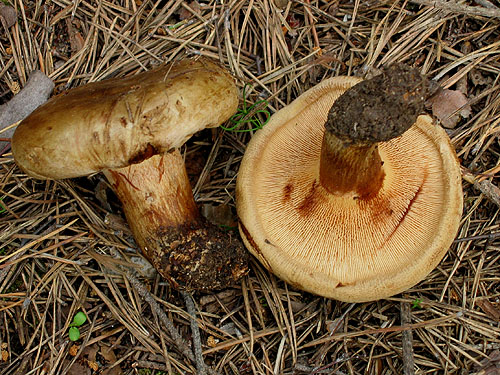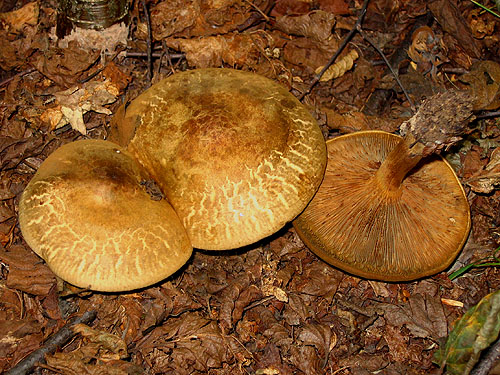Paxillus Fr.
Cap depressed to funnel-shaped, velvety or tomentose, later smooth, cap margin inrolled and remaining so for a long time. Gills forking. Spore print rusty, brownish or vinaceous.
At least eight species are described in Europe. With exception of Paxillus rubicundulus, that is relatively easy to recognize, the rest of the species gravitate closely around Paxillus involutus.
The colour of the spore print is thought to be important for the species recognition, so it should be thoroughly noted when freshly deposited. The crystal that occur in the rhizomorphs are also considered important so any Paxillus collection must contain fruitbodies with preserved basal mycelium.
Reaction with ammonia solution is used to separate some of the species. It has been proven in other bolete genera that the ammonia reaction has little (if any) taxonomic value. However, it has not been evaluated in Paxillus and it should be tested systematically.
Paxillus involutus (Batsch : Fr.) Fr.
Description
Cap depressed to funnel shaped, velvety or smooth, cap margin tomentose, ochraceous, ochraceous brown, yellowish brown, reddish brown or rusty, usually strongly inrolled and remaining so for a long time. Stipe cylindrical, not exuding droplets at the base. Gills forking, pale ochraceous, more brownish at maturity, bruising brownish. Flesh pale yellowish, turning more reddish when exposed to air. Spore print olive brown to rusty. Spores 7–11 × 5–6.5 μm. Rhizomorphs with small crystals (up to 0.5 μm).
Habitat. Woodlands and scrubland, hedges and under solitary trees in parks and gardens. Mycorrhizal with a wide spectrum of trees, but often seen under birch (Betula), poplars (Populus), spruce (Picea) and pines (Pinus). Encountered sometimes on rotting hardwood.
Distribution. In Europe widespread, although its distribution is somewhat obscured after few other species were recognized on the continent.
Similarity. Compare closely with the rest of the species in Paxillus.
Photographs

Fruitbodies of Paxillus involutus. Note the inrolled velvety cap margin. (photo B. Assyov)

Fruitbodies of Paxillus involutus. (photo B. Assyov)
Important literature
Henrici, A. 2004. A key to Paxillus s. l. in Europe. – Field Mycology 5(3): 87–88.
Hahn, C. & Agerer, R. 1999. Studien zum Paxillus involutus Formenkreis. – Nova Hedwigia 69: 241–310.
Knudsen, H. & Vesterholt, J. [eds.]. 2008. Funga Nordica. Nordsvamp, Kopenhagen.
Šutara, J. 1992. The genera Paxillus and Tapinella in Central Europe. – Ceská Mykologie 46: 50–56.
Watling, R. & Hills, A.E. 2005. Boletes and their allies (revised and enlarged edition). – In: Henderson, D.M., Orton, P.D. & Watling, R. [eds]. British Fungus Flora. Agarics and boleti. Vol. 1. Royal Botanic Garden, Edinburgh.